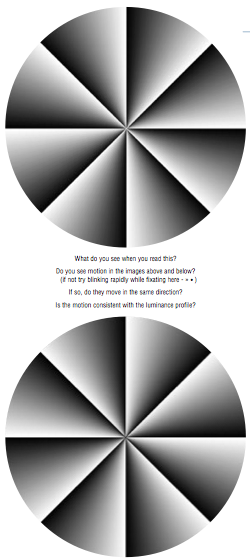Peripheral drift illusion
The peripheral drift illusion (PDI) is an optical illusion that creates the illusion of motion in peripheral vision. Numerous versions of the PDI exist, including a version entitled "rotating snakes" that has become very popular. Like many perceptual illusions, the PDI plays an important role in helping scientists study and understand the processes involved with vision and perception. It also provides endless fascination to people, reflecting our cognitive curiosity and appreciation for creativity that is part of human nature.
Discovery
The peripheral drift illusion was first described by Jocelyn Faubert and Andrew Herbert in a 1999 article in the scholarly journal Perception. A similar illusion called the escalator illusion was reported much earlier in 1979 by Fraser and Wilcox. One of the most popular versions of the PDI, rotating snakes, was created by Kitaoka and Ashida in 2003, who modified certain aspects of the illusion to create a more powerful version.
Description
When looking at a PDI, one observes apparent rotation of the figures in the peripheral field. Looking at any particular spot proves that the image is not, in fact, rotating, as the illusion only occurs in the areas that are not being directly focused on. If one fixates steadily upon a portion of the image, the effect vanishes. The illusion is easily seen when fixating off to the side, and then blinking as fast as possible. Most observers see the illusion easily when reading text with the illusion figure in the periphery. Motion is consistently perceived in a dark-to-light direction, so the two circles in Faubert and Hubert's classic figure (at right) should appear to spin in opposite directions.
Explanation
Faubert and Herbert proposed that the PDI was caused by eye movements or blinks, as well as differing latencies in the processing of luminance, as well as the way differing signals are processed in the periphery. They suggested that these temporal differences in luminance processing produce a signal that tricks the motion perception system into perceiving motion where there is none.
Researchers do not yet understand exactly what causes the illusion of motion with PDIs, but have observed that processing related to the perception of related illusions appears to take place in specific areas of the brain.[1] Most current theories are similar in nature to that of Faubert and Herbert, with the acknowledgment that contrast also appears to play a large role in the strength of the illusion.
Applications
Like many perceptual illusions, the PDI plays an important role in helping scientists study and understand the processes involved with vision and perception. Stronger versions of the PDI, such as the "rotating snakes" version, may create a stronger reaction in the brain and make it easier for scientists to pinpoint exactly what causes the perception of motion.
Notes
- â Thomas Ramsøy, "The Peripheral Drift Illusion" 2004. Retrieved January 3, 2008.
ReferencesISBN links support NWE through referral fees
- Backus, B. T. and İ Oruç. 2005. Illusory motion from change over time in the response to contrast and luminance. Journal of Vision, 5(11), 1055-1069.
- Conway, B. R., A. Kitaoka, A. Yazdanbakhsh, C. C. Pack, and M. S. Livingstone. 2005. Neural basis for a powerful static motion illusion. Journal of Neuroscience, 25, 5651-5656.
- Faubert, J. and A. M. Herbert. 1999. The peripheral drift illusion: A motion illusion in the visual periphery Perception, 28, 617-622.
- Fraser, A., Wilcox, K. J. 1979. Perception of illusory movement. Nature, 281, 565-566.
- Kitaoka. A., and H. Ashida. 2003. Phenomenal characteristics of the peripheral drift illusion. Vision, 15, 261-262.
External links
All links retrieved November 23, 2022.
- Rotating snakes at Akiyoshi's illusion pages.
- Rotating rings at Sarcone's optical illusion pattern page.
Credits
New World Encyclopedia writers and editors rewrote and completed the Wikipedia article in accordance with New World Encyclopedia standards. This article abides by terms of the Creative Commons CC-by-sa 3.0 License (CC-by-sa), which may be used and disseminated with proper attribution. Credit is due under the terms of this license that can reference both the New World Encyclopedia contributors and the selfless volunteer contributors of the Wikimedia Foundation. To cite this article click here for a list of acceptable citing formats.The history of earlier contributions by wikipedians is accessible to researchers here:
The history of this article since it was imported to New World Encyclopedia:
Note: Some restrictions may apply to use of individual images which are separately licensed.
